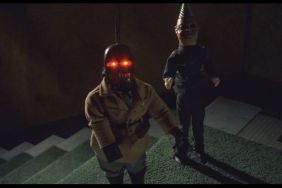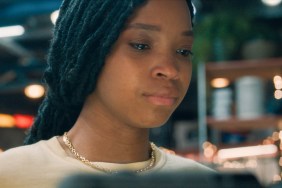
The horror anthology has made a minor comeback in recent years, though its resurgence can be attributed almost entirely to independent filmmakers. Apart from Trick r’ Treat (all but abandoned by Warner Bros.), films like V/H/S and The ABCs of Death were made outside of the studio system, allowing them to indulge in more risqué fare than the likes of Creepshow or Cat’s Eye. So it’s a good time to revisit From A Whisper To A Scream, an independent anthology from 1987 that served as the debut feature from Jeff Burr, who would go on to become something of a sequel specialist (Stepfather 2, Texas Chainsaw 3, Puppet Master 4 & 5…). It’s interesting that the main work he’d get after this film would be retreads, since one of Whisper‘s key assets is how off the beaten path the four stories are.
It’s also got a pretty great concept for its wraparound, which stars Vincent Price as a librarian and Susan Tyrell as a reporter looking for information on Prices niece, who was just executed on Death Row. She wonders why Price wasn’t there, and he explains that the town itself (the fictional Oldfield, Tennessee) is to blame, as it has a history of turning its residents’ souls dark. The four stories he tells to prove his point all take place in the town, albeit during different time periods. He starts off with a contemporary tale and works his way back to the Civil War. This builds to a pretty great twist at the end, capping off an above average entry in the anthology sub-genre, one without a single outright dud in its lineup.
Of course, some stories are better than others, but compared to modern anthology films like ABCs, where you have some real gems running alongside the nearly unwatchable, it’s refreshing to go back to a time when there was more consistency in the presentation. The first is probably my favorite since it’s the most insane; it packs necrophilia, mutant babies, vague incest, and Clu Gulager singing all in under 20 minutes!
Gulager plays Stanley, an introvert who spends his days fawning over a woman at his office and his nights taking care of his nearly invalid sister (played by Gulager’s real life wife, Miriam Byrd-Nethery). One day, he finally works up the courage to ask the coworker out, but the date doesn’t go as planned and he ends up killing her before he can get past second base. But death doesn’t stop him from getting there (in her coffin at the funeral home no less), and when the film then cuts to “Nine Months Later,” you can guess what will happen next. Or maybe you can’t, since it’s so damn weird. Either way, it starts the film on a high note.
The others aren’t quite as depraved, but we still get a number of batshit plot points and taboo violence. The second tale features Terry Kiser (Bernie!) as a mob stooge on the run who gets injured and falls into a swamp, where he’s later rescued by a local voodoo man (Harry Caesar). Kiser grows healthier and demands more of the man’s medicine, and things get out of hand. It’s probably the least necessary story in the lineup, though Kiser and Caesar are fun to watch and the ending is highly satisfying.
The next one goes back in time a bit to focus on a traveling circus, which features a man (Ron Brooks) who can eat glass, metal, razor blades, etc. A lovely young woman (Martine Beswick) falls in love with the performer, and hes torn between her and the circus, as he is “owned” by Rosalind Cash, who has given him his unique power, and can take it away just as easily. FX fans will probably enjoy this one the most. It presents a variety of sharp objects protruding from Brooks body, as his ability to keep these inedible objects in his system wanes.

And the final story comes close to being my favorite, featuring Cameron Mitchell* as a drunken, horrible soldier during the Civil War who finds himself held prisoner by a group of kids. Despite the excessive gore, this entry feels more like a Twilight Zone episode than full blown horror, and I almost wish it was saved for a full feature.
The film’s low budget roots are occasionally felt, mostly in the editing (sometimes entries feel choppy, as if they were reduced from features), but never in the actingrarely has a film been blessed with so many genre faves. This would be one of Price’s final genre roles, and he’s giving it his all even though (as we learn in the bonus features) he hardly jumped at the chance to be in the film. All of the segments feature one of those great B-movie stars that tend to make junky movies that much more interesting just by showing up. Seeing them all “together” is a true delight, marred only by the realization that so much of the cast has passed away since. Of the film’s first seven billed actors, only two are still with us (Culager and Kiser), and you’ll spot even more of the deceased in bit roles, such as the great Lawrence Tierney as the prison warden in the opening sequence. Stupid mortality, always ruining our fun.
The unusually high death rate among the cast means that the obligatory making-of retrospective (titled Return to Oldfield) is heavy on crew, light on cast, though that doesn’t mean any stone is left unturned. As the piece runs a whopping two hours (the movie itself is only 97 minutes) you can walk away an expert on the film, even with the reduced number of participants. Director Burr, co-writer C. Courtney Joyner, co-writer/producer Darin Scott, and several of the co-producers (plus Gulager in some archive footage) tell the story of the film’s entire history, from its inception through the lengthy casting process (most of the movie was shot by the time they finally got Price on board), all the way up to its aborted but still fairly successful release. They holding nothing back and clearly have fond memories of the production and the outcome of the film itself. No one is under the impression that it’s a perfect movie, but they’re still rightfully proud of what they pulled off with such minimal money and experience. It’s just as engaging as the film itself.
Impressively, Burr rarely repeats any information on his feature commentary, which he does solo (rare for a Scream Factory release) and yet almost never even pauses to breathe, let alone catch himself watching the movie without a moderator to prod him along. When Price comes up, he says he won’t bother explaining the (hilarious) story of his casting since they covered it on the documentary, and tells other anecdotes about him instead. Why can’t all commentaries be like this? Darin Scott also provides one, though after two viewings of the film I couldn’t bring myself to check it out just yet. Still, Scott (who also produced the great Tales From The Hood, which was the last traditional horror anthology to play in wide release) is an engaging presence and I’m sure his track is worth a listen.

Instead, I used my time to check out A Decade Under the Innocence, another feature length doc featuring Burr and some of his cohorts, showcasing their early love for 8mm film and how they learned to be filmmakers by futzing around with the once ubiquitous device. It’s a shame none of the full “features” could be included on the disc as well, but the glimpses we see in between their interview segments are charming in their lack of verisimilitude, with kitchens and living rooms subbing for office buildings and the like, not to mention the “actors” (parents, local business owners, etc) giving Sofia Coppola levels of naturalism in their performances. As a kid who used to play around with his dad’s video camera (one cherished memory: being inspired by Memoirs of an Invisible Man to make my own version, with objects on not-invisible strings subbing for my lack of a greenscreen), I ate this stuff up, and love Scream Factory for including it. The trailer is also included (along with some TV spots), though I couldn’t get it to play. The film was originally released as The Offspring (which is strange as it can only apply to the Gulager story), so that’s the title on the marketing material, though it’s been released under its correct title for years now.
Needless to say, if you’re a fan of this flick, the Blu-ray is a must-buy. The transfer is great, and it will literally take you the better part of a waking day to go through everything on the disc. If I had the time to watch it all every time, I’d want every disc to have this kind of wealth of supplements, where you not only get all the info you want about the movie itself, but even a bonus history of something tangentially related. It sets a pretty high standard on how to deliver a quality presentation for a library title, and when you consider Scream Factory puts out a new special edition almost every week, it’s even more impressive. A terrific disc.
—
*Two years before, he appeared in Night Train to Terror, another horror anthology that is somehow even more batshit than this one.
Brian, aka BC, has been watching horror movies since the age of 6, and twenty years later decided to put it to good use, both as a writer for several leading genre sites, as well as launching his own, Horror Movie A Day, which Roger Ebert once read and misunderstood the points that were being made. Follow him @BrianWCollins









